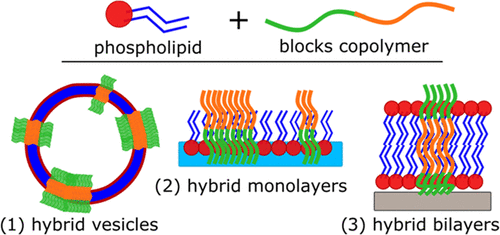Our official English website, www.x-mol.net, welcomes your feedback! (Note: you will need to create a separate account there.)
Organized Hybrid Molecular Films from Natural Phospholipids and Synthetic Block Copolymers: A Physicochemical Investigation.
Langmuir ( IF 3.9 ) Pub Date : 2020-08-27 , DOI: 10.1021/acs.langmuir.0c01544 Arianna Balestri 1, 2 , Leonardo Chiappisi 2 , Costanza Montis 1 , Samantha Micciulla 2 , Barbara Lonetti 3 , Debora Berti 1
Langmuir ( IF 3.9 ) Pub Date : 2020-08-27 , DOI: 10.1021/acs.langmuir.0c01544 Arianna Balestri 1, 2 , Leonardo Chiappisi 2 , Costanza Montis 1 , Samantha Micciulla 2 , Barbara Lonetti 3 , Debora Berti 1
Affiliation

|
In the last few years, hybrid lipid-copolymer assemblies have attracted increasing attention as possible two-dimensional (2D) membrane platforms, combining the biorelevance of the lipid building blocks with the stability and chemical tunability of copolymers. The relevance of these systems varies from fundamental studies on biological membrane-related phenomena to the construction of 2D complex devices for material science and biosensor technology. Both the fundamental understanding and the application of hybrid lipid-copolymer-supported bilayers require thorough physicochemical comprehension and structural control. Herein, we report a comprehensive physicochemical and structural characterization of hybrid monolayers at the air/water interface and of solid-supported hybrid membranes constituted by 1,2-dipalmitoyl-sn-glycero-3-phosphocholine (DPPC) and the block copolymer poly(butadiene-b-ethyleneoxide) (PBD-b-PEO). Hybrid lipid-copolymer supported bilayers (HSLBs) with variable copolymer contents were prepared through spontaneous rupture and fusion of hybrid vesicles onto a hydrophilic substrate. The properties of the thin films and the parent vesicles were probed through dynamic light scattering (DLS), differential scanning calorimetry (DSC), optical ellipsometry, quartz crystal microbalance with dissipation monitoring (QCM-D), and confocal scanning laser microscopy (CSLM). Stable, hybrid lipid/copolymer systems were obtained for a copolymer content of 10–65 mol %. In particular, DSC and CSLM show lateral phase separation in these hybrid systems. These results improve our fundamental understanding of HSLBs, which is necessary for future applications of hybrid systems as biomimetic membranes or as drug delivery systems, with additional properties with respect to phospholipid liposomes.
中文翻译:

来自天然磷脂和合成嵌段共聚物的有序杂化分子膜:物理化学研究。
在过去的几年中,混合脂质-共聚物组件作为二维(2D)膜平台成为可能,将脂质构件的生物相关性与共聚物的稳定性和化学可调性相结合,引起了越来越多的关注。这些系统的相关性从对生物膜相关现象的基础研究到用于材料科学和生物传感器技术的2D复杂设备的构造不等。混杂脂质共聚物支持的双层的基本理解和应用都需要全面的理化理解和结构控制。在这里,我们报告了在空气/水界面处的杂化单分子层和由1,2-二棕榈酰-sn构成的固体支持的杂化膜的综合理化和结构表征-甘油-3-磷酸胆碱(DPPC)和嵌段共聚物聚(丁二烯-b-环氧乙烷)(PBD- b-PEO)。通过自发破裂并将杂化囊泡融合到亲水性基质上,制备具有可变共聚物含量的杂化脂质共聚物支撑的双层(HSLB)。通过动态光散射(DLS),差示扫描量热法(DSC),光学椭圆仪,带耗散监测的石英晶体微天平(QCM-D)和共聚焦扫描激光显微镜(CSLM)来探测薄膜和母囊的特性。 。获得稳定的杂化脂质/共聚物体系,共聚物含量为10-65 mol%。尤其是,DSC和CSLM在这些混合系统中表现出横向相分离。这些结果改善了我们对HSLB的基本理解,这对于混合系统在未来的应用(如仿生膜或药物递送系统)必不可少,
更新日期:2020-09-22
中文翻译:

来自天然磷脂和合成嵌段共聚物的有序杂化分子膜:物理化学研究。
在过去的几年中,混合脂质-共聚物组件作为二维(2D)膜平台成为可能,将脂质构件的生物相关性与共聚物的稳定性和化学可调性相结合,引起了越来越多的关注。这些系统的相关性从对生物膜相关现象的基础研究到用于材料科学和生物传感器技术的2D复杂设备的构造不等。混杂脂质共聚物支持的双层的基本理解和应用都需要全面的理化理解和结构控制。在这里,我们报告了在空气/水界面处的杂化单分子层和由1,2-二棕榈酰-sn构成的固体支持的杂化膜的综合理化和结构表征-甘油-3-磷酸胆碱(DPPC)和嵌段共聚物聚(丁二烯-b-环氧乙烷)(PBD- b-PEO)。通过自发破裂并将杂化囊泡融合到亲水性基质上,制备具有可变共聚物含量的杂化脂质共聚物支撑的双层(HSLB)。通过动态光散射(DLS),差示扫描量热法(DSC),光学椭圆仪,带耗散监测的石英晶体微天平(QCM-D)和共聚焦扫描激光显微镜(CSLM)来探测薄膜和母囊的特性。 。获得稳定的杂化脂质/共聚物体系,共聚物含量为10-65 mol%。尤其是,DSC和CSLM在这些混合系统中表现出横向相分离。这些结果改善了我们对HSLB的基本理解,这对于混合系统在未来的应用(如仿生膜或药物递送系统)必不可少,



























 京公网安备 11010802027423号
京公网安备 11010802027423号